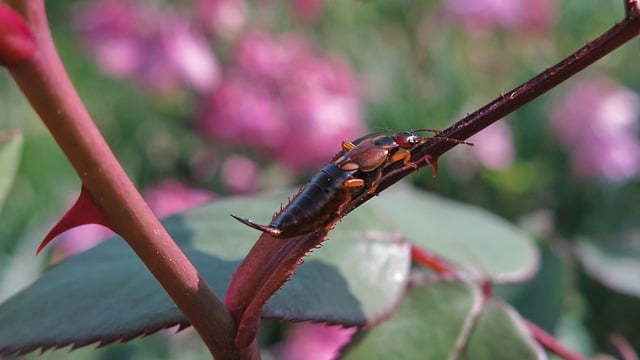Earwigs, nocturnal garden pests, cause damage by feeding on leaves, stems, and roots, leading to stunted growth and destroyed seedlings. Prevention involves understanding their attractants (moisture and scent) and implementing strategies like removing decaying plant matter and ensuring proper drainage. Regular evening checks and preventive measures are crucial. Earwigs prevention services use natural repellents, traps, and beneficial insects, or offer professional integrated pest management for persistent infestations, focusing on specific earwig types and entry points while minimizing environmental impact.
Protecting your garden from earwig damage is essential for maintaining a thriving outdoor space. Earwigs, despite their harmless appearance, can wreak havoc on plants, feeding on leaves and stems. This article guides you through understanding these nocturnal pests, identifying infestations, and implementing effective prevention strategies. Learn natural methods to keep earwigs at bay and when to consider professional earwigs prevention services for a lush, healthy garden.
Understanding Earwigs and Their Impact on Plants
Earwigs are a common garden pest that can cause significant damage to plants. These nocturnal creatures feed on a variety of plant materials, including leaves, stems, and roots. While they prefer decaying organic matter, earwigs can also inflict harm on healthy plants, especially young shoots and flowers. Their presence can lead to noticeable chewed leaves, stunted growth, and even the destruction of seedlings.
Understanding how earwigs preventively services work is key to protecting your garden. Earwigs are drawn to certain scents and moisture levels, so reducing these attractants can be an effective strategy. This includes maintaining good garden hygiene by removing decaying plant matter and ensuring proper drainage. Professional earwig prevention services often employ natural repellents, traps, or even beneficial insects to deter these pests without resorting to harsh chemicals.
Identifying Earwig Infestations in Your Garden
Earwig infestations can go unnoticed for quite some time, making it essential to learn their identifying signs. One of the most visible indicators is the presence of the insects themselves. Earwigs are typically 1-2 inches long, with a flat, elongated body and a pair of cerci, which look like small pincers at the rear end. They often hide in tight spaces during the day, becoming active at night when they feed on plants. You might spot them along plant stems or in soil cracks. Additionally, keep an eye out for chewed plant parts, especially at the base of leaves and flowers. Earwigs are attracted to moisture and decomposing organic matter, so damp areas in your garden could be prime locations for their nests. If you notice these signs, it’s time to consider earwig prevention services to protect your plants.
Regular monitoring is a crucial part of earwigs prevention. Check your garden during the evening hours when earwigs are most active. Look for live insects or their shed skins, which can indicate an ongoing infestation. Some preventive measures include keeping your garden clean and free of debris, using traps near affected plants, and ensuring proper drainage to reduce moisture levels. By being proactive and utilizing earwig prevention services, you can safeguard your garden from these damage-causing pests.
Effective Earwigs Prevention Strategies
Protecting your garden from earwig damage starts with implementing effective earwigs prevention strategies. One of the most crucial steps is maintaining a clean and tidy garden environment, as earwigs are attracted to organic debris and dark, narrow spaces. Regularly removing dead plant material, cutting back overgrown vegetation, and securing garbage cans with tight-fitting lids can significantly deter these pests. Additionally, using earwigs prevention services that employ natural repellents like mint oil or diatomaceous earth can be highly effective without harming beneficial insects.
Another important strategy is to ensure proper drainage in your garden, as earwigs are drawn to areas with stagnant water. Fixing leaky hoses and ensuring smooth water flow in irrigation systems will make your garden less appealing to them. Planting aromatic herbs like basil, lavender, and rosemary around the perimeter of your garden can also act as a natural barrier, as earwigs tend to avoid strong scents. Incorporating these earwigs prevention services into your gardening routine will help safeguard your plants from these damaging pests.
Professional Earwigs Prevention Services: When to Seek Help
If your garden has become a victim of earwig invasions, it might be time to consider professional earwigs prevention services. While there are many DIY solutions and preventive measures you can take as a homeowner, expert interventions come into play when the infestation is severe or persistent. Professional services offer specialized knowledge and advanced techniques tailored to effectively manage earwig populations.
Hiring licensed professionals ensures your garden receives top-notch care. They employ integrated pest management strategies, combining chemical and non-chemical methods for long-lasting results. These experts can identify the specific types of earwigs causing damage, determine their points of entry, and implement targeted treatments, making your garden less appealing to these pests while minimizing environmental impact.
Protecting your garden from earwig damage is a multi-faceted approach. By understanding these pests, identifying infestations early, and employing effective prevention strategies, you can keep your plants healthy and vibrant. If the issue persists, consider seeking professional earwigs prevention services to ensure a thorough and lasting solution. With dedication and the right tools, you can enjoy a lush, earwig-free garden all season long.
